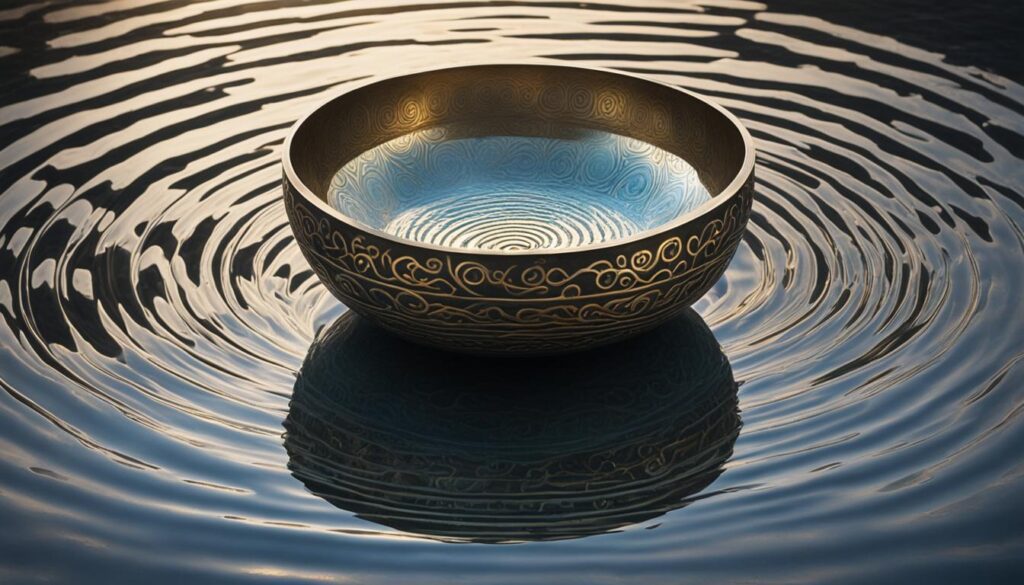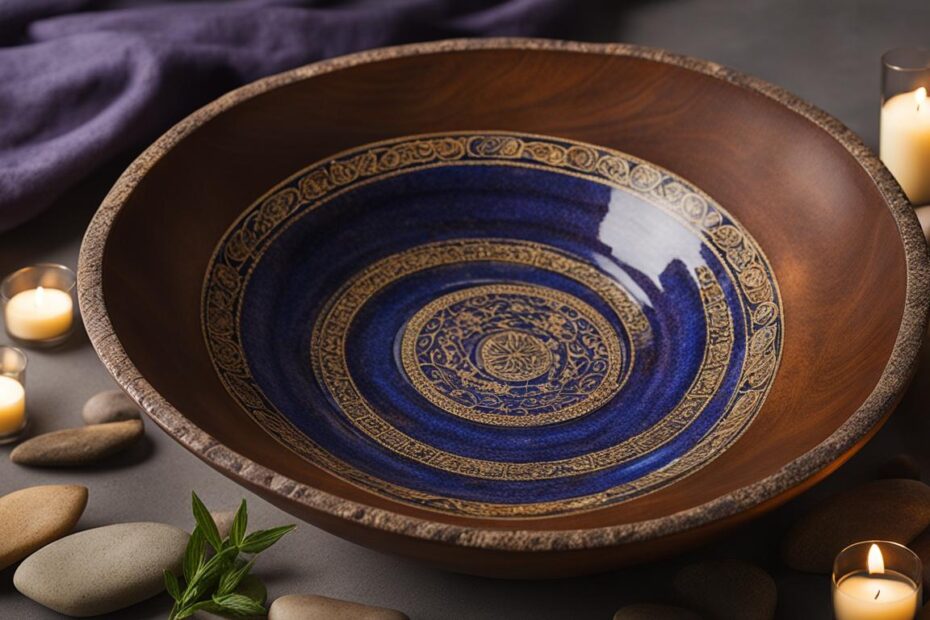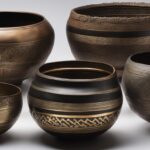Discover the rich history and profound significance of prayer bowls. These ancient artifacts have captivated civilizations for centuries, providing a tangible connection to our spiritual roots. From their origins in regions like Tibet, Nepal, and India to their evolution and modern uses, prayer bowls hold a unique place in our collective history.
Key Takeaways:
- The history of prayer bowls dates back thousands of years, with the earliest metal bowls made of pure copper.
- Prayer bowls were used for practical purposes but also held ceremonial and sound healing significance.
- These bowls have cultural importance, being used in ceremonies, rituals, and spiritual practices.
- Prayer bowls have become historical artifacts, providing insights into ancient cultures and practices.
- Modern uses of prayer bowls include relaxation, meditation, and creating a soothing atmosphere.
Evolution of Prayer Bowls
Prayer bowls have a rich history that spans thousands of years, with their origins rooted in ancient civilizations. Over time, these sacred bowls have undergone significant changes in materials and craftsmanship techniques, shaping their evolution.
The earliest prayer bowls were crafted from pure copper, showcasing the ingenuity and skill of their makers. These exquisite metal bowls were meticulously fashioned, reflecting the intricate craftsmanship of their time. As the art of bowl-making progressed, brass emerged as the preferred material due to its unique properties and resonance.
Brass, a combination of copper and other metals, brought a new dimension to prayer bowls. The alloy’s composition enhanced the sound quality and healing properties of the bowls, elevating their significance in spiritual practices. The evolution of prayer bowls highlights the adaptability of artisans who continuously sought to refine their creations.
The craftsmanship of prayer bowls has become a time-honored tradition, passed down through generations. Skills and knowledge are shared within communities, preserving the artistry and legacy of these sacred objects. Nepal, renowned for its rich cultural heritage, has been a hub for prayer bowl production, utilizing materials sourced from the nearby Tibetan region.
The intentions of the makers of these ancient bowls may not always be clear, as time has obscured the specifics. However, the unique alloys and sound qualities of the prayer bowls continue to captivate people around the world, transcending centuries of history.

Evolution of Prayer Bowls
| Time Period | Materials | Key Characteristics |
|---|---|---|
| Ancient Times | Pure Copper | Exquisite craftsmanship, pure resonating sound |
| Evolutionary Phase | Brass (Copper + Other Metals) | Enhanced sound quality, improved resonance, and healing properties |
Cultural Significance of Prayer Bowls
Prayer bowls hold immense cultural importance in various spiritual practices worldwide. For centuries, these special bowls have played a vital role in ceremonies, rituals, and religious traditions. The melodic tones and gentle vibrations produced by the bowls create an atmosphere of serenity and inner peace, making them popular tools for meditation and relaxation.
In different cultures, prayer bowls have been utilized for various purposes. They have been used for divination, a practice aimed at gaining insight into the future or receiving spiritual guidance. The reverberating sound waves emitted by the bowls were believed to have the power to connect with the divine and provide answers to pressing questions.
The cultural significance of prayer bowls extends beyond their use in spiritual contexts. They have become treasured possessions, often crafted with exquisite detail and handed down through generations. Special bowls were made to order or gifted to monasteries and revered religious institutions, signifying their spiritual importance.
Prayer bowls are not merely objects; they are symbols of spiritual connection and profound devotion.
These symbolic artifacts hold a special place in the hearts of individuals and communities alike. Their profound cultural significance serves as a reminder of humanity’s ongoing search for spirituality and a way to connect with the greater universe.
The Traditional Uses of Prayer Bowls
| Traditional Uses | Description |
|---|---|
| Meditation and relaxation | The soothing tones and vibrations of prayer bowls aid in achieving a sense of calm and centeredness, providing a serene environment for meditation and relaxation. |
| Sound therapy | Prayer bowls are often used in sound therapy sessions, where the vibrations produced by the bowls are believed to promote both physical and mental well-being. |
| Divination | In certain cultures, prayer bowls are used in divination practices to seek guidance, clarity, and spiritual insight into future events or decision-making processes. |
These traditional uses demonstrate the multifaceted nature of prayer bowls and their ability to assist individuals on their spiritual journeys.

The cultural importance of prayer bowls transcends boundaries, weaving together ancient traditions, spirituality, and the human quest for inner peace. These symbolic vessels continue to inspire and connect people to their spiritual essence, providing a tangible reminder of our shared spiritual heritage.
Historical Artifacts of Prayer Bowls
Prayer bowls have transcended their original purpose and have become historical artifacts that offer valuable insights into ancient cultures and practices. These sacred objects are now found in museums, private collections, and archaeological sites, where they serve as windows to the past. The historical relevance of prayer bowls lies in their cultural, spiritual, and artistic value.
Many prayer bowls, especially the oldest ones, are thick and heavy, suggesting their use as a form of currency in ancient societies. They were often exchanged as wedding gifts or used as a storehouse of value, reflecting the significance placed on these objects. The craftsmanship and materials used in the creation of prayer bowls provide a glimpse into the skills and metallurgy of the regions where they were made.
The value of prayer bowls as historical artifacts extends beyond their mere functionality. These bowls offer a tangible connection to ancient traditions and beliefs, serving as vessels of cultural heritage. Their intricate designs and symbolism showcase the artistic prowess of the craftsmen who created them, further highlighting their historical significance.
In understanding the historical artifacts of prayer bowls, we gain a deeper appreciation for the rich tapestry of human history and the enduring power of these sacred objects to preserve ancient wisdom and traditions.
Singing Bowls and Water Vibration
Singing bowls, also known as prayer bowls, have long been used for their healing properties and ability to induce relaxation. These metal bowls produce resonating vibrations when struck or played, which can have a profound impact on the body, mind, and soul.
But what makes singing bowls truly unique is their interaction with water. Water is known for its ability to react to vibrations, and when exposed to the vibrations of singing bowls, it comes to life, moving and dancing in choreographed patterns. This phenomenon has fascinated researchers and practitioners alike, leading to the belief that the vibrations produced by singing bowls can have a positive effect on the water in our bodies, promoting overall well-being.
The combination of sound, vibration, and water creates a unique energy that is thought to enhance meditation and induce a deep sense of calm. As our bodies are made up of approximately 60% water, it is believed that the vibrations from singing bowls can resonate with the water within us, creating a harmonizing effect that aligns our body, mind, and spirit.
When we immerse ourselves in the gentle tones and vibrations of singing bowls, we allow the water within us to respond and resonate with these frequencies. This can have a calming effect on our nervous system, reducing stress and anxiety. It can also help to balance our energy centers, known as chakras, promoting a sense of harmony and well-being.
The Healing Power of Water and Sound
“Water is the driving force of all nature.” – Leonardo da Vinci
The healing power of water has been recognized for centuries, with ancient civilizations using water in various forms for purification and restoration. Combining the healing properties of water with the soothing vibrations of singing bowls amplifies the therapeutic benefits, creating a synergistic effect.
The vibrations produced by singing bowls can penetrate deep within our bodies, stimulating our cells and promoting the flow of energy. This can help to release stagnant emotions and blockages, allowing for a greater sense of vitality and well-being. When combined with the fluid nature of water, these vibrations can have an even more profound impact.
Imagine the gentle ripple effect created by a pebble dropped into a calm pond. The vibrations spread outwards, touching everything in their path. Similarly, the vibrations of singing bowls ripple through the water within us, touching every cell, and bringing about a sense of balance and harmony.
As we immerse ourselves in the healing sounds of singing bowls, we become like the water, flowing and adapting to the vibrations. We allow ourselves to become fully present in the moment, surrendering to the soothing tones and allowing them to wash over us, cleansing and renewing our body, mind, and soul.
The Benefits of Singing Bowls and Water Vibration
The effects of singing bowls on water vibration are believed to have a wide range of benefits for our well-being. Here are some of the potential effects of experiencing singing bowls and water vibration:
- Relaxation and stress reduction
- Improved sleep quality
- Enhanced meditation practice
- Increased focus and concentration
- Release of emotional blockages
- Enhanced creativity and intuition
- Deep sense of calm and balance
The combination of water vibration and singing bowls has the power to restore and rejuvenate our entire being. It is a gentle yet powerful tool for self-care and healing, allowing us to tap into the natural rhythms and energies of the world around us.

The Effects of Singing Bowls on Water Vibration
| Effects | Description |
|---|---|
| Harmonizing | The vibrations from singing bowls promote a harmonious flow of energy within the water in our bodies, restoring balance and well-being. |
| Cleansing | The vibrations help to release stagnant energy and emotions, cleansing the water within us and promoting a sense of renewal. |
| Calming | The gentle tones and vibrations have a soothing effect on our nervous system, reducing stress and anxiety. |
| Energizing | The vibrational energy of singing bowls can stimulate the flow of energy, revitalizing our cells and promoting a sense of vitality. |
| Transformative | The combination of water vibration and singing bowls has the power to bring about transformative experiences, helping us to connect with our true selves and inner wisdom. |
Origins of Singing Bowls
Singing bowls, also referred to as Tibetan singing bowls, have a rich and ancient history that can be traced back thousands of years. While the exact origins of these fascinating instruments remain uncertain, evidence suggests that they were first made in Mesopotamia over 5,000 years ago. Originally crafted from pure copper, these bowls served both medicinal and musical purposes.
The art of bowl making was passed down through generations, evolving over time as the bowls were made from various metals, including brass—a combination that includes copper. The craftsmanship involved in creating singing bowls has deep cultural significance, making them one of the most ancient artisan crafts in human history.

Singing bowls have a profound connection to ancient civilizations, embodying the wisdom and traditions of past cultures. The journey of these bowls from their earliest beginnings to their present-day use is a testament to the enduring power and timeless beauty of these remarkable instruments.
Craftsmanship of Singing Bowls
The craftsmanship of singing bowls is a testament to the artistry and dedication of the artisans who create them. These skilled craftsmen and craftswomen possess a deep understanding of the traditional methods used to make these unique instruments.
The process begins with the selection of high-quality metals, such as bronze, copper, or brass, which are known for their rich tonal qualities. The metal is then heated to a red-hot malleable state, allowing the artisan to shape the bowl using various techniques like sand-casting or hammering.
Each strike of the hammer is deliberate and precise, as the bowl takes shape and its sound is carefully cultivated. The artisans demonstrate immense skill and patience, ensuring that the vibrations and resonances of the bowl produce a harmonious and soothing tone.
After the shaping process, the bowl undergoes meticulous polishing, which not only enhances its visual appeal but also refines the sound quality. Some bowls may also feature intricate designs or etchings, further highlighting the artisan’s attention to detail and artistic flair.
The craftsmanship of singing bowls often involves collaboration between multiple artisans, each bringing their unique skills and expertise to the creation of these exceptional instruments. This collaborative effort adds depth and complexity to the final product, resulting in a bowl that is truly a work of art.
It’s important to note that the traditional methods of making singing bowls have been passed down through generations, particularly in regions like Nepal, where the craft has been preserved and cherished. However, the rise of mass production in the West has raised concerns about cultural appropriation. To ensure the integrity of these cultural treasures, it is essential to support fair trade sources when purchasing singing bowls.

Modern Uses of Singing Bowls
Singing bowls have seamlessly integrated into modern wellness practices, becoming a staple in various settings such as yoga studios, sound therapy spaces, and massage therapy centers. These enchanting instruments are cherished for their ability to create a sense of relaxation, promote mindfulness, and establish a soothing atmosphere.
When played, singing bowls produce ethereal sounds that have a profound calming effect on the mind and body. The resonating vibrations emitted by these bowls help individuals enter a state of deep relaxation, enhancing the overall meditation experience. The mesmerizing tones generated by singing bowls can assist in increasing focus, attaining inner peace, and reducing stress levels.
“The resonance and vibrations of singing bowls are believed to have healing properties, making them ideal for promoting overall well-being.”
These extraordinary vibrations and resonances are thought to possess healing properties that positively impact the mind, body, and spirit. Singing bowls are often utilized during wellness practices to facilitate energy balancing, chakra cleansing, sound therapy, and relaxation techniques. The harmonious vibrations emitted by the bowls are believed to stimulate self-healing processes, restore balance, and promote a sense of well-being.
In today’s modern world, singing bowls continue to hold their historical significance while also being highly valued for their spiritual and therapeutic benefits. Their captivating sounds and profound impact have led them to be an essential tool in modern wellness practices, supporting individuals in their journey towards holistic well-being and self-discovery.
The Modern Uses of Singing Bowls
Singing bowls have become increasingly prevalent in modern wellness practices, enhancing the therapeutic benefits of various practices such as:
- Meditation and Mindfulness: The serene tones and harmonious vibrations of singing bowls are instrumental in creating a peaceful and focused atmosphere for meditation and mindfulness practices. The soothing sounds help individuals achieve a state of deep relaxation and inner clarity.
- Yoga and Movement Practices: Many yoga practitioners incorporate singing bowls into their practice as a way to enhance the mind-body connection and promote a sense of alignment. The resonance of the bowls can deepen the overall experience and provide an auditory anchor for movement.
- Sound Therapy and Energy Healing: Singing bowls are often used in sound therapy sessions and energy healing practices. The vibrations produced by the bowls can help release energetic blockages, balance the chakras, and promote overall energetic harmony.
- Stress Reduction and Relaxation: The tranquil sounds and vibrations of singing bowls have a profound impact on reducing stress and promoting relaxation. The rhythmic tones create a calming environment, allowing individuals to unwind and rejuvenate.
- Ambiance and Well-Being: Singing bowls are also used to create an ambient and tranquil atmosphere in various wellness spaces such as spas, massage therapy centers, and wellness retreats. The gentle resonance of the bowls enhances the overall experience and fosters a sense of well-being.
Through their enchanting sounds and transcendent vibrations, singing bowls continue to enrich modern wellness practices, providing individuals with a peaceful sanctuary for relaxation, healing, and inner exploration.
The Mystery of Singing Bowl Origins
The origins of singing bowls remain shrouded in mystery, as historical records and folklore provide limited insight into their creation. Some researchers believe these intriguing instruments were first crafted in Mesopotamia, while others argue that the Himalayan region holds the true birthplace of singing bowls.
Regardless of their exact origin, singing bowls are believed to be one of the oldest artisan crafts in human history. The earliest versions were handcrafted using pure copper, showcasing the ancient ingenuity and craftsmanship of their creators.
“Singing bowls are not just musical instruments; they are expressions of our connection to the divine and our desire for healing.” – Tibetan Master
Singing bowls have long been revered for their medicinal and spiritual properties. The sounds produced by these ancient healing instruments have a profound effect on brainwave entrainment, inducing relaxation and facilitating healing.
Scientific studies have shown that the vibrations and frequencies emitted by singing bowls can synchronize brainwaves, promoting a sense of calm and well-being. This phenomenon, known as brainwave entrainment, has been utilized for centuries in various cultures as a powerful tool for enhancing meditation and promoting overall wellness.
Ancient Healing Through Brainwave Entraining
| Benefits of Singing Bowls in Brainwave Entrainment | Ailments |
|---|---|
| Relaxation and Stress Reduction | Anxiety, Insomnia |
| Pain Relief and Healing | Chronic Pain, Inflammation |
| Enhanced Meditation and Mindfulness | Poor Concentration, Restlessness |
The soothing tones and vibrations produced by singing bowls have been harnessed for their therapeutic benefits, offering individuals a pathway to transcend stress, alleviate physical ailments, and achieve a deeper state of relaxation and meditation.
Value and Future of Antique Singing Bowls
Antique singing bowls are not merely objects of beauty; they hold immense historical and cultural value. These treasured artifacts provide a glimpse into ancient practices and the craftsmanship of bygone eras. Each antique singing bowl tells a unique story, steeped in tradition and spiritual significance.
The value of antique singing bowls can vary depending on several factors. The age of the bowl, the craftsmanship involved in its creation, and its rarity all contribute to its overall worth. Some bowls may hold significant monetary value, sought after by collectors and enthusiasts alike. However, the true value of these antique bowls lies in their cultural and spiritual significance.
Antique singing bowls serve as tangible connections to our ancestors’ rituals and beliefs. They are revered for their ability to produce soothing and healing sounds that resonate with the soul. These bowls were once integral to ancient ceremonies, meditation practices, and spiritual rituals, making them sacred objects of reverence.
As interest in singing bowls continues to grow in the modern world, the value of antique singing bowls may increase in the future. Their rarity and historical importance make them highly sought-after pieces for those seeking a deeper connection to ancient wisdom and spiritual practices.
It is essential, however, to approach the buying and selling of antique singing bowls with knowledge and respect for their historical and cultural importance. Authenticity and provenance should be carefully considered, ensuring the preservation of the integrity of these precious artifacts.
As the allure of antique singing bowls continues to transcend time, their value remains timeless. These artifacts serve as remarkable reminders of our collective heritage and the enduring power of sound and spirituality in shaping human experiences.
The Symbolism of Antique Singing Bowls
In addition to their intrinsic value, antique singing bowls boast symbolic significance that enhances their appeal. These symbols often reflect the spiritual and cultural beliefs of the societies that produced them. Some common symbols found on antique singing bowls include:
| Symbol | Meaning |
|---|---|
| Lotus Flower | Symbolizes purity, enlightenment, and spiritual growth. |
| Om Symbol | Represents the primordial sound, encompassing the past, present, and future. |
| Dragon | Symbolizes power, wisdom, and good fortune. |
| Dorje | Signifies thunderbolt or diamond, representing indestructibility and spiritual transformation. |
| Eight Auspicious Symbols | These symbols include the endless knot, lotus flower, conch shell, victory banner, fish, wheel, parasol, and treasure vase. Each symbol carries its unique auspicious connotations. |
The symbolism etched or engraved onto antique singing bowls adds depth to their aesthetic appeal, giving them profound significance in spiritual practices and ceremonial rituals.
Singing Bowls in the Modern World
Singing bowls have transcended their historical origins and have gained immense popularity in the modern world. These enchanting bowls can now be found in various settings, including healing centers, yoga studios, classrooms, and temples. The mesmerizing sounds and gentle vibrations emitted by singing bowls have become an integral part of wellness routines and practices, captivating people from different cultures and backgrounds.
People are drawn to the soothing and centering effects of singing bowls, using them as powerful tools for relaxation, meditation, and mindfulness. The calming resonance produced by these bowls creates a serene atmosphere, allowing individuals to enter a state of deep relaxation and inner harmony.
“The calming sounds of the singing bowls instantly transport me to a place of tranquility and peace. They help me find balance and clarity amidst the chaos of everyday life.” – Sarah, a regular practitioner of mindfulness meditation.
Singing bowls have become increasingly popular in the modern spiritual and therapeutic landscape due to their ability to induce a profound sense of calm and well-being. The vibrations emitted by these bowls are believed to harmonize the body and mind, promoting a deep sense of relaxation and inner healing.
The Power of Singing Bowls in Wellness Practices
Singing bowls have found their rightful place in wellness practices, providing a powerful and transformative experience. Let’s explore the various ways in which singing bowls are utilized in the modern world:
- Meditation: The resonating sounds and vibrations of singing bowls help individuals enter a meditative state more easily. As the mind focuses on the soothing tones, it becomes easier to let go of distractions, promoting a deeper sense of presence and mindfulness.
- Yoga and Mindfulness: Singing bowls are often integrated into yoga and mindfulness classes to enhance the overall practice. The gentle sounds of the bowls create a calming ambiance, allowing practitioners to connect with their breath and find inner stillness.
- Sound Therapy: Singing bowls are used in sound therapy sessions to promote relaxation, reduce stress, and alleviate physical discomfort. The vibrational energy of the bowls is believed to stimulate the body’s natural healing mechanisms, restoring balance and harmony.
Through their versatility and profound effects, singing bowls have become cherished instruments in the pursuit of holistic well-being and spiritual growth.
| Benefits of Singing Bowls in the Modern World | Illustrative Examples |
|---|---|
| Stress Relief | Reduces stress and anxiety levels |
| Improved Sleep | Enhances sleep quality and promotes relaxation |
| Focus and Clarity | Enhances focus, concentration, and mental clarity |
| Emotional Healing | Aids in emotional release and promotes emotional well-being |
| Energy Balancing | Restores balance and harmony to the body’s energy systems |
| Spiritual Connection | Fosters a deeper sense of spiritual connection and self-discovery |
As the popularity of singing bowls continues to grow, more individuals are embracing their transformative power and incorporating them into their daily lives.
In conclusion, singing bowls have carved a special place for themselves in the modern world, captivating people with their enchanting sounds and soothing vibrations. From healing centers to yoga classes, singing bowls have become cherished companions on the journey towards inner peace and well-being. Their popularity is a testament to the profound impact they have on individuals’ physical, mental, and spiritual states. As we embrace the modern world, singing bowls serve as a gentle reminder of the timeless wisdom and healing power they hold.
Conclusion
The history of prayer bowls is a testament to the timeless craftsmanship, cultural significance, and spiritual practices that have spanned centuries. These bowls have evolved and adapted over the years, yet they retain their historical and cultural relevance. The soothing sounds and gentle vibrations produced by prayer bowls continue to draw individuals in search of relaxation, healing, and spiritual connection.
Whether used in traditional ceremonies or incorporated into modern wellness practices, prayer bowls serve as powerful reminders of the rich tapestry of human history. They embody the enduring power of sound and vibration to instill a sense of calm and centeredness in our lives.
As we explore the mysteries of prayer bowl origins and value their historical artifacts, we are reminded of the profound impact these bowls have had on various cultures and practices. Moving forward, prayer bowls will continue to captivate individuals from all walks of life, providing a bridge between our past and present, and serving as conduits for meditation, introspection, and spiritual growth.
FAQ
What is the history and significance of prayer bowls?
Prayer bowls have a history spanning thousands of years, with the earliest metal bowls made of copper over 5,000 years ago. These bowls were used for practical purposes but also had ceremonial and healing uses. They originated in regions like Tibet, Nepal, and India and hold cultural importance in various spiritual practices.
How have prayer bowls evolved over time?
Prayer bowls have evolved in terms of materials and craftsmanship. While the earliest bowls were made of copper, later iterations were made of brass. They were designed with specific resonance and sound healing qualities in mind. The craftsmanship of prayer bowls has been passed down through generations, with many bowls being made in Nepal using materials from Tibet.
What is the cultural significance of prayer bowls?
Prayer bowls have been used for centuries in ceremonies, rituals, and religious practices. The calming sound and vibrations produced by these bowls create a sense of calm and centeredness, making them popular tools for meditation and relaxation. In some cultures, prayer bowls were used for divination or as part of sound therapy. They are treasured artifacts and symbols of spiritual connection.
What is the historical significance of prayer bowls?
Prayer bowls are historical artifacts that provide insights into ancient cultures and practices. They can be found in museums, private collections, and archaeological sites. The craftsmanship and materials used in these bowls reflect the skills and metallurgy of the regions where they were made. They hold historical relevance in terms of their cultural, spiritual, and artistic value.
How do singing bowls interact with water vibration?
Singing bowls produce resonating vibrations that can impact the body, mind, and soul. When exposed to these vibrations, water reacts by moving and dancing in choreographed patterns. This phenomenon has led to the belief that the vibrations produced by singing bowls can positively affect the water in our bodies and promote overall well-being.
What are the origins of singing bowls?
While the exact origins of singing bowls are uncertain, there is evidence to suggest they were first made in Mesopotamia over 5,000 years ago. These bowls were initially made of pure copper and were used for medicinal and musical purposes. The craftsmanship of singing bowls has been passed down through generations.
How are singing bowls crafted?
Crafting a singing bowl is a meticulous process that requires skill and patience. Artisans heat the metal to a malleable state and shape it using techniques like sand-casting or hammering. The bowls are then polished and may be etched with designs. Multiple artisans with different skills often collaborate in the craftsmanship of singing bowls.
What are the modern uses of singing bowls?
Singing bowls can be found in various settings such as healing centers, yoga studios, and sound therapy spaces. They are used for relaxation, meditation, centering work, and creating a soothing atmosphere. The calming sounds and vibrations of singing bowls have a therapeutic effect and are believed to promote overall well-being.
What is the mystery surrounding the origins of singing bowls?
The origins of singing bowls remain somewhat mysterious, with limited historical records and folklore surrounding their creation. Some researchers believe they were first made in Mesopotamia, while others point to the Himalayan region as their birthplace. The healing properties of the sounds produced by singing bowls have been scientifically proven.
What is the value and future of antique singing bowls?
Antique singing bowls hold historical and cultural value. Their value can vary depending on factors such as age, craftsmanship, and rarity. Some bowls may have significant monetary value, while others are valued for their cultural and spiritual significance. As interest in singing bowls grows, their value in the future may increase.
How are singing bowls utilized in the modern world?
Singing bowls have gained popularity in the modern world and can be found in various settings such as wellness centers, yoga studios, and temples. They are used as tools for relaxation, meditation, and mindfulness. The calming and centering effects of singing bowls appeal to individuals from different cultures and backgrounds.








